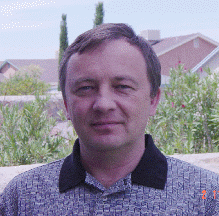Professor
snsm@nmsu.edu | (575) 646-1547
Fax: (575) 646-2649 | Lab: 646-2144 (lab, CB112)

- M.S., Novosibirsk University, Russia 1982
- Ph.D., Novosibirsk University, Russia 1987
- Postdoctoral, Dartmouth College, NH 1995
- Research Assistant Professor, Dartmouth College, NH 1995-1998
Office: CB202 | Office Hours (F2016): Monday, Wednesday 11:30 – 12:30 or by appointment
PUBLICATIONS GROUP WEBSITE COURSES
Research
My group studies physicochemical aspects of nanomaterials and their applications including hybrid nanoporous materials in drug delivery and sensors, fundamental aspects of CVD growth of 2D materials (graphene, h-BN) and their applications in sensors, desalination, photovoltaic devices, and composite materials. Research Projects can be divided into the following categories:
Intracellular Drug Delivery and Cell Transfection: Nanotubes and nanoporous mebranes and are applied for these goals with emphasis on targeted delivery with new physical mechanisms of drug release.
Graphene and its applications: Fundamental aspects of graphene growth via atmospheric pressure chemical vapor deposition (APCVD) and its application as membranes for sensors, desalination, photovoltaic devices, composite materials and others.
Sensors: Various physico-chemical phenomena can often be applied to detect chemical and biological species. We have been focusing on sensors based on nanoporous membranes with simple electrical and optical means of detection.
Electron transfer: Electron transfer processes play a fundamental role in chemistry, physics and biology. Such processes can be initiated by light or, instead, result in formation of electronically excited species able to emit optical photons. We investigate the photoinduced electron transfer reactions in solutions and at interfaces. Transient displacement current technique, fluorescence spectroscopy and kinetics as well as scanning probe microscopy and magnetic resonance spectroscopy are primary tools in these studies. Intra and intermolecular charge transfer have been investigated including photovoltaic and electroluminescent devices.
Scanning probe microscopy: Many chemical and biochemical phenomena can be now addressed almost on a single molecule level. Scanning probe microscopy in a form of STM, AFM and their various modifications have become powerfull tools in such in such investigations. We have been applying them to study mechanical and electrical properties of single molecules and their aggregates on surfaces.
Dr. Smirnov teaches the following courses:
Chem 100 (Basic Chemistry): SP12,F12, F13
Chem 110 (Principles of Chemistry): F10
Chem 111 (General Chemistry I): F98,F99
Chem 112 (General Chemistry II): SP01
Chem 115 (Principles of Chemistry I): F03
Chem 116 (Principles of Chemistry II): SP01
Chem 431 (Physical Chemistry for the Biosciences): F03,F05,F07
Chem 433 (Physical Chemistry I): F08,F11,F14,F15,F16
Chem 434 (Physical Chemistry II): SP09
Chem 435 (Physical Chemistry Laboratory): SP99-SP10,SP13,SP14,SP15
Chem 537 (Quantum Chemistry): F00,F02,F06,F12,F14,F16
Chem 538 (Kinetics): F09
Chem 539 (Spectroscopy): SP00,SP02,SP10,F11,F13
Chem 580 (Phys.Chem. Discussion): F03,SP04,SP07
Chem 639 (Experimental Physical Chemistry): SP06,SP10,SP14
Other teaching activities:
Chemistry Exercises
All publications
